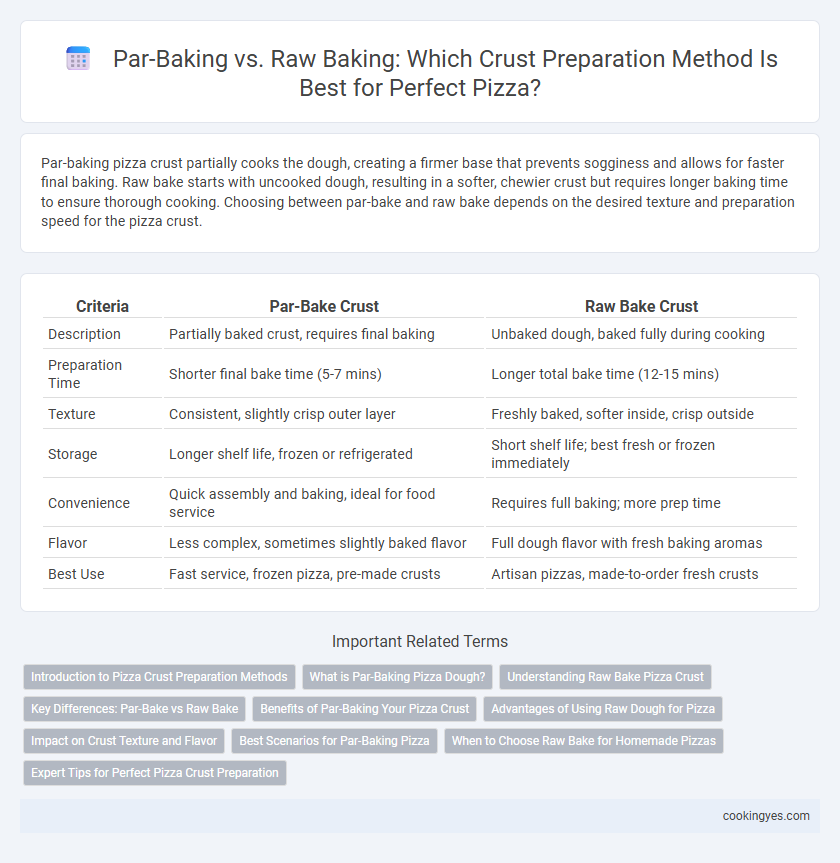Par-baking pizza crust partially cooks the dough, creating a firmer base that prevents sogginess and allows for faster final baking. Raw bake starts with uncooked dough, resulting in a softer, chewier crust but requires longer baking time to ensure thorough cooking. Choosing between par-bake and raw bake depends on the desired texture and preparation speed for the pizza crust.
Table of Comparison
| Criteria | Par-Bake Crust | Raw Bake Crust |
|---|---|---|
| Description | Partially baked crust, requires final baking | Unbaked dough, baked fully during cooking |
| Preparation Time | Shorter final bake time (5-7 mins) | Longer total bake time (12-15 mins) |
| Texture | Consistent, slightly crisp outer layer | Freshly baked, softer inside, crisp outside |
| Storage | Longer shelf life, frozen or refrigerated | Short shelf life; best fresh or frozen immediately |
| Convenience | Quick assembly and baking, ideal for food service | Requires full baking; more prep time |
| Flavor | Less complex, sometimes slightly baked flavor | Full dough flavor with fresh baking aromas |
| Best Use | Fast service, frozen pizza, pre-made crusts | Artisan pizzas, made-to-order fresh crusts |
Introduction to Pizza Crust Preparation Methods
Par-baking pizza crust partially cooks the dough to create a firmer base that prevents sogginess from toppings, ideal for thick or stuffed pizzas. Raw bake involves baking the uncooked dough along with toppings, allowing a softer, chewier crust with fuller flavor development. Choosing between par-bake and raw bake depends on desired crust texture, topping moisture, and cooking time preferences.
What is Par-Baking Pizza Dough?
Par-baking pizza dough involves partially baking the crust before adding toppings to create a firmer base that prevents sogginess during the final bake. This technique ensures a crispier texture and reduces overall cooking time, making it ideal for pizzas with moist ingredients. Compared to raw bake, par-baked crusts maintain structural integrity and enhance flavor development through slight caramelization.
Understanding Raw Bake Pizza Crust
Raw bake pizza crust offers greater customization by allowing full control over dough fermentation and hydration levels, resulting in a fresher, more flavorful base. Unlike par-baked crusts, raw dough absorbs toppings better during baking, which enhances moisture balance and prevents sogginess. This method requires precise temperature management and baking time to achieve optimal texture and crispness.
Key Differences: Par-Bake vs Raw Bake
Par-bake pizza crust is partially baked before adding toppings, allowing for a crispier texture and faster final bake, which is ideal for consistent results in commercial kitchens. Raw bake involves using uncooked dough that fully cooks with the toppings, providing a chewier, fresher crust but requiring longer baking time and precise temperature control. Key differences include baking time, texture, and operational efficiency, with par-bake offering convenience and consistency, while raw bake delivers a more traditional, artisanal quality.
Benefits of Par-Baking Your Pizza Crust
Par-baking your pizza crust improves texture by creating a sturdy base that resists sogginess from toppings and sauces, resulting in a crispier final product. This method reduces overall cooking time, enabling faster service and more consistent results in commercial kitchens. Additionally, par-baking enhances dough shelf life and allows for greater flexibility in pizza preparation without compromising quality.
Advantages of Using Raw Dough for Pizza
Using raw dough for pizza crust allows for better texture control, resulting in a crispier edge and a chewier interior due to the dough's ability to bake fully during cooking. It offers greater flexibility in topping preparation, as the crust adapts to various moisture levels and ingredient weights without becoming soggy. Additionally, raw dough enables enhanced flavor development through oven spring and Maillard reaction, creating a more authentic, artisanal pizza experience.
Impact on Crust Texture and Flavor
Par-baking pizza crust partially cooks the dough, creating a firmer base that reduces sogginess and allows for a crispier texture when finished baking with toppings. Raw bake methods produce a softer, chewier crust with a more pronounced yeasty flavor due to the full baking process occurring after the assembly. Texture and flavor differences between par-bake and raw bake crusts directly affect the final mouthfeel and taste profile, influencing customer preference and preparation efficiency.
Best Scenarios for Par-Baking Pizza
Par-baking pizza crust is ideal for creating a crisp, sturdy base that prevents sogginess when using moisture-rich toppings like fresh vegetables or tomato sauce. This method is particularly beneficial for delivery pizzas, as it ensures the crust maintains its texture during transport and reheating. Restaurants and home cooks prefer par-baking for thicker crusts or stuffed pizzas to achieve even cooking without burning the exterior.
When to Choose Raw Bake for Homemade Pizzas
Raw bake pizza crust is ideal for homemade pizzas when you want a fresher, more artisanal texture and flavor. This method allows the dough to develop a crispy outer layer while maintaining a chewy interior, especially when cooked at high temperatures for short periods. Choose raw bake if you plan to customize toppings extensively, as it ensures even cooking without sogginess or premature crust hardening.
Expert Tips for Perfect Pizza Crust Preparation
Par-baking pizza crust partially cooks the dough, ensuring a crispier texture and preventing sogginess when adding toppings, ideal for thicker crusts or deep-dish styles. Expert tips recommend baking the crust at a high temperature (450-500degF) for 4-6 minutes during par-bake, allowing the dough to set without browning. For raw bake, dough must be rolled evenly and prebaked only if necessary; this method suits thin crusts and quick baking, preserving a chewier, fresher texture.
Par-bake vs Raw bake for crust preparation Infographic

 cookingyes.com
cookingyes.com